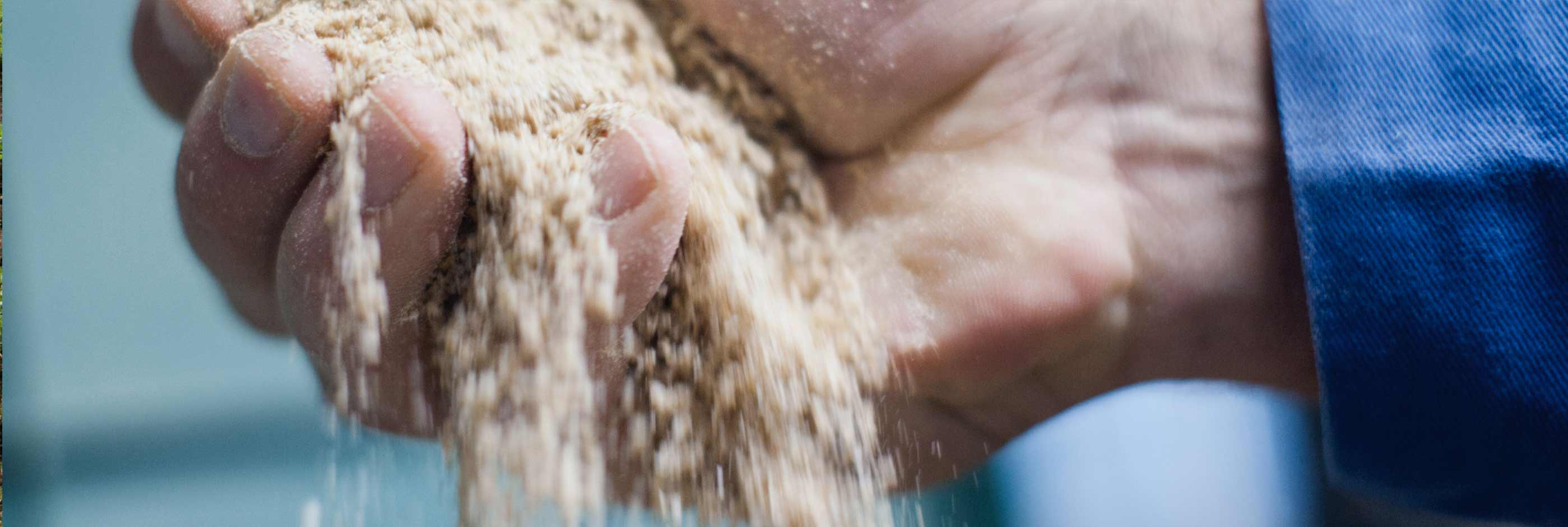Keeping high protein levels and good revenues using functional fiber in nursery diets
By Hamlet Protein
Many nutritionists reduce crude protein (CP) levels to cope with ZnO free diets. Another motive to use lower CP levels in nursery diets is to reduce feed costs. However, reducing the CP content of nursery diets may be a costly decision as the risk exists that within the total amino acid (AA) absorption from a low CP diet some AA may become deficient compared to the required level for nursery pigs. Consequently, growth performance is impaired and very important; feed conversion rate goes up.
However, keeping protein levels brings the risk of excessive fermentation in the hindgut which leads to pathogenic growth and thus post-weaning diarrhea (PWD). To avoid this from happening most measures are directed towards fixing the problem of pathogenic growth by means of antimicrobial or anti-inflammatory feed additives.
At Hamlet Protein we believe it is more effective to eliminate the cause of this pathogenic growth; the undigested protein going to the hindgut where it is fermented by various pathogens.
Protein of high quality – why it is so important
The weaning from liquid, highly digestible sow milk to solid, plant-based feed challenges the young pig’s immature digestive system resulting in suboptimal protein digestion. Undigested protein ends up in the hindgut where it is fermented by potential pathogenic bacteria. Protein quality is defined by both digestibility and the absence of gut health disturbing anti-nutritional factors (ANF’s) but also absorption speed making protein quality key in terms of meeting nutrient requirements and preserving gut health.
Free amino acids supplemented as synthetic amino acids in feed are absorbed faster than amino acids bound in protein (Yen et al., 2004; Nørgaard et al., 2021). Thus, fast absorption of protein bound amino acids is required to optimize the utilization of the ingested amino acids as this will result in a better synchronization of amino acids in blood. As a result, more of the ingested protein is retained in the body which is then used for performance (growth) and less nitrogen is excreted into the environment (Hu et al., 2022).
Soybean meal (SBM), the most widely used protein source in nursery diets, has a high content of ANF’s that has been shown to reduce protein digestibility (Jansman et al., 1998) and induce damage to intestinal epithelium (Peng et al., 2018), consequently having detrimental effects on performance of young animals (Teague et al., 2023).
Nursery diets should therefore contain clean protein sources that are highly digestible and fast absorbable to optimize performance and gut health of the young pig. To further safeguard gut health, the use of functional fiber as proven to be quite effective.
The role of functional fiber
Functional fiber can consist of soluble and insoluble fiber. Soluble fibers and prebiotic carbohydrates (CHO’s) serve as substrate for microbiota residing in the hindgut that use it to produce short-chain fatty acids (SCFA) such as butyrate. The insoluble fibers exert their beneficial effect by having a physical effect in the gut stimulating peristaltic movements and reducing the adhesion of potential pathogenic bacteria to the gut wall (Molist et al., 2014).
In Hamlet Protein, we have conducted a series of trials with HP FiberBoost, our functional fiber that contains both soluble and insoluble fibers as well as prebiotic CHO’s. Common to all trials is that HP FiberBoost exerts gut health preserving properties. The results show that the presence of soluble fibers and prebiotic CHO’s in HP FiberBoost stimulates the production of beneficial metabolites such as butyrate and reduces the fermentation of protein as indicated by lower concentration of branched-chain fatty acids (BCFA; figure 1). Since hindgut fermentation of protein is associated with the presence of potentially harmful bacteria, results further suggest that HP FiberBoost can induce competitive exclusion of potential pathogenic bacteria in the hindgut. Growth of more favorable microbiota safeguards gut health and therefore also (future) performance of the newly weaned piglet.
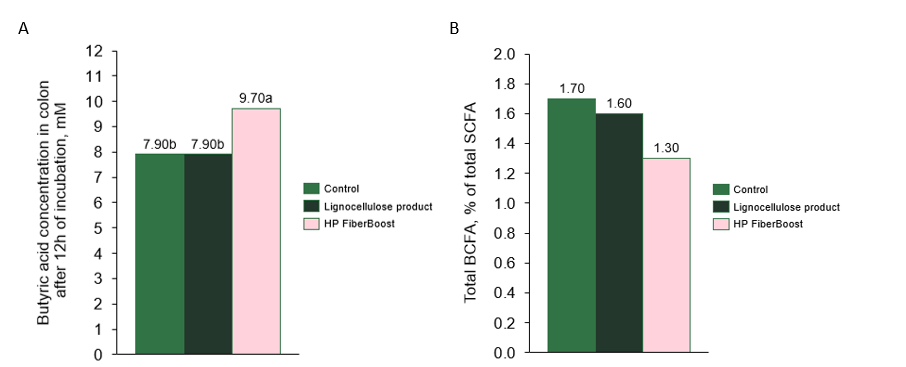
Figure 1 Concentration of A) butyric acid (mM) and B) branched-chain fatty acids (BCFA, % of total SCFA) in colon digesta after 12 hours of incubation with no added fiber (control), a lignocellulose product or HP FiberBoost (Thirup et al., 2021).
The HP feeding concept for weaned piglets: HP 300 and HP FiberBoost
Many farms use complex nursery diets containing various feed additives to ease the weaning transition. In addition, it has become common practice to lower the level of protein in the diet to further reduce the risk of PWD as response to the European Union-ban on medicinal levels of ZnO in nursery diets. Both being costly initiatives in the effort to reduce the risk of PWD.
A recent trial (results not published) showed that nursery diets with reduced protein level (Low CP: 17% CP D0-14 and 16% D14-41) resulted in a revenue loss of 2.70 euros/pig due to reduced growth and worsened FCR as compared to diets with high protein levels (High CP: 19% CP D1-14 and 18% D14-41). On the other hand, the addition of HP FiberBoost (4% D0-14 and 3% D14-41) to the high protein nursery diet (High CP + HP FiberBoost) improved piglets’ resilience, shown as fewer pigs lost, and improved herd uniformity by 1.6 percentage units (11.56% vs 9.94%, respectively) while growth performance at good feed conversion rate (FCR) was maintained as compared to a diet without added fiber (High CP; figure 2). These improvements caused by the addition of HP FiberBoost to a high protein diet resulted in an additional gain of 1.4 euros/pig.
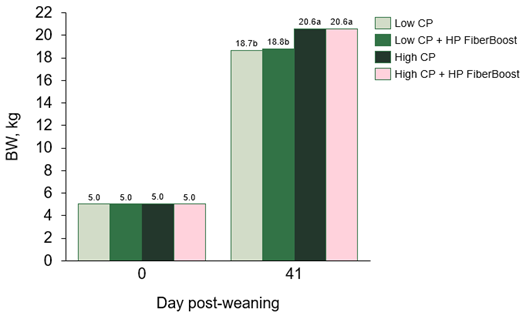
Figure 2 Body weight (BW, kg) of pigs fed low or high protein diets (Low CP or High CP) with or without HP FiberBoost. Different letters withing column indicate significant differences (p<0.05). .
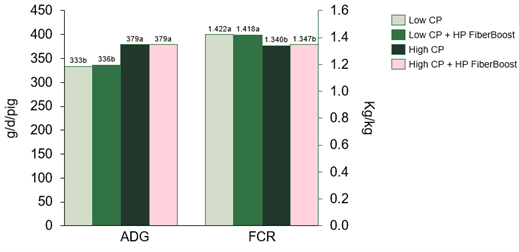
Figure 3 Average daily gain (ADG, g/d/pig) and feed conversion rate (FCR, kg/kg) of pigs fed low or high protein diets (Low CP or High CP) with or without HP FiberBoost. Different letters withing column indicate significant differences (p<0.05)..
Likewise, the use of fibers makes it possible to feed simpler diets and thus reduce feed costs. Piglets fed a complex diet containing various gut health promoting feed additives (control) or cheaper diets containing only fiber as feed additive (lignocellulose based (insoluble) or HP FiberBoost) showed equal performance (results not published). Thus, increasing the fiber content of the diet did not compromise performance. On the other hand, results from this trial showed that the type of fiber matters. Pigs fed the HP FiberBoost diet containing both soluble and insoluble fibers were more resilient evident by fewer pigs lost (figure 2) compared to the lignocellulose product and the complex control diet, which was a lot more expensive.
.
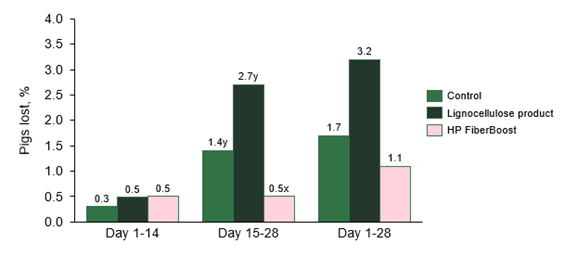
Figure 4 Pigs lost (mortality+removals, %) that were fed a complex diet(control) or a simple nursery diet with a lignocellulose product or HP FiberBoost. x,y indicate a near-significant trend (p<0.10).
The outcomes of the above-described trials confirm that the HP Feeding Concept combining a high-quality protein source with the functional fiber HP FiberBoost in nursery diets results in more resilient piglets and at the same time allows high protein content in weaner diets. This is due to the combined effect of a highly digestible, fast absorbable protein that improves nutrient utilization and soluble and insoluble fiber that stimulate microbial fermentation and exert a physical effect in the gastrointestinal tract, respectively.
It is generally accepted that piglets have a high requirement for protein. Now, evidence suggest that pigs also have a basal requirement for fiber – and results summarized in this article, suggests that piglets do not only need insoluble fiber but also have a requirement for soluble fiber to stimulate microbial fermentation in the hindgut and preserve a healthy gut.
The HP Feeding Concept, in which HP 300 and HP FiberBoost are combined, fulfills both requirements and allows for normal CP levels to support optimal growth performance in the nursery phase.
References available upon request
HP 300 AND HP FiberBoost. Stress free weaning = higher revenues
Combining the unique properties of HP 300 with HP FiberBoost allows to keep high CP levels in nursery diets without losing performance.
Vi visited swine farmer Søren Stenskrog to talk about his experience with our products.
Thank you to Søren Stenskrog - Swine farmer and Birgitte Bendixen Møller - Consultant Elite Opti for participating in this video.
